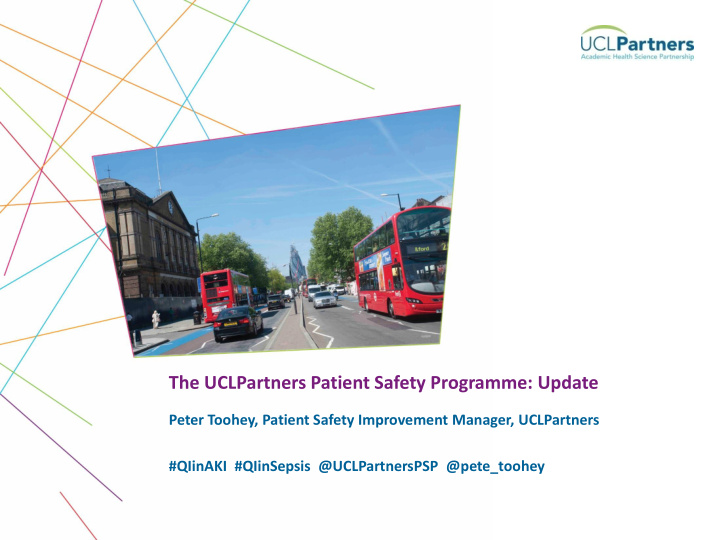



The UCLPartners Patient Safety Programme: Update Peter Toohey, Patient Safety Improvement Manager, UCLPartners #QIinAKI #QIinSepsis @UCLPartnersPSP @pete_toohey
Patient Safety Priority Matrix
Together, Sepsis & AKI account for two thirds of potential mortality avoided from the top 8 interventions nationally Intervention Potential PYLL (per 100,00) Benefit – <75 Lives saved (per 100,00) 1 Implementation of NICE guideline on Acute Kidney Injury 19 (PYLL reduction all ages estimated at 161) 2 Implementation of the Sepsis Six Care Bundle 18 - 3 Implementation of British Thoracic Society Care Bundle 6 83 for community acquired pneumonia 4 Increased prescription of anti-thrombotics (warfarin) for 4 28 patients with atrial fibrillation 5 Earlier stage of diagnosis of cancer 3 29 6 Intermittent Pneumatic Compression to prevent post 2 14 stroke Deep Vein Thrombosis 7 Prevention of Venous Thromboembolism 2 - 8 Increased update of cardiac rehabilitation 1 10 Reconfiguration of hyper acute stroke services along the lines of London stroke services reconfiguration was also identified as a priority, although assessments of the relative benefits of national roll-out are complex 3 Source: NHS England
The IHI breakthrough series collaborative engine
UCLPartners Sepsis Collaborative Driver Diagram AIM PRIMARY DRIVERS SECONDARY DRIVERS KEY MEASURES Reliable screening Recognise- 1. All six vital signs recorded within Reliable identification Prompt identification of 15 minutes of presentation (RR, & treatment of sepsis patient with Sepsis SpO 2 , HR, BP, AVPU / GS, including in UCLP partner New Confusion , temperature) organisations Reliable referral process, Inform- 2. The word ‘sepsis’ written / communications & Immediate referral to highlighted / ticked in patient doctor/nurse able to deliver documentation record within 1 hour of Outcome: treatment presentation 3. Documented iv antibiotics within Reduction in mortality Reliable, timely treatment Treat- 1 hour of presentation in pilot population Timely care delivery (e.g., iv & source control 4. Blood cultures obtained within antibiotics within 1 hour) hour 20% by March 2017 5. ≥500 mL iv fluid given within 1 Recheck after treatment Evalutate- hour of presentation (unless clear Antimicrobial stewardship Follow-up review contra-indication) 6. Documented review within 3 Education Education and Awareness hours after presentation (+/-30 Training mins.) 7. Evidence of escalation if not Executive sponsorship Culture of Safety & Quality improved (no reduction in NEWS Clinicial leadership Improvement score / NEWS score still ≥5) M.D.T. working 8. Documented review of Measurement antimicrobial therapy within 48 hours of presentation Patient involvement Patient & Family Centred Care Process measurement plan Review ≥10 patient records each month where patients’ ≥18 years old, on non -elective / emergency pathway, for active treatment; likely to have sepsis, e.g. blood cultures taken in first 24hours, or in ICD-10 codes A40/A41. Denominator is number of patients’ reviewer identifies with evidence of severe / ‘red flag’ / new definition sepsis – or septic shock – in the ED (or ward). Numerator values are numbers of patients with evidence for each of eight recommended indicators.
‘ STOP AKI ’ - Driver Diagram AIM PRIMARY DRIVERS EXAMPLE : SECONDARY DRIVERS (COLLABORATIVELY (LOCALLY DESIGNED AND TESTED) AGREED) * Staff awareness and engagement campaign * Recruit AKI improvement team and MDT champions in acute admitting areas and ED * Staff training and education programme in admitting areas * Launch local guideline/pathway/’bundle’, AKI outreach team Blood test at triage, point of care creatinine, fast-track blood sample delivery, Door to recognition of AKI priority ED and acute medicine laboratory runs, install LIMS detection algorithm less than 4 hours* with biochemistry phone out to teams, install LIMS detection algorithm with automated e-alert, AKI status in admission proforma (nursing or medical) Reduce 30 day mortality Door to fluids and/or Training on fluid assessment in ED/AMU, rapid cannulation, nurse led-resuscitation, following admission with antibiotics in grab bags or sepsis trolley, antiobiotic guidance, senior review for fluid assessment AKI by 25% from baseline sepsis/hypoperfusion AKI all AKI value less than 6 hours* To increase by 25% Door to cessation of Staff education, incorporate AKI nephrotoxin screening in medicines proportion of patients nephrotoxins where drug reconciliation/nursing admission/medical admission/consultant ward round review, who recover renal toxicity contributory less e-prescribing screening and decision support for AKI, early pharmacy review all AKI function (20% baseline patients than 12 hours* creatinine) at 30 days Increase imaging capacity for ED/acute medicine patients with AKI, radiological Door to Relief of obstruction prioritisation of AKI requests, use of CT KUB if limited US capacity, strengthen Improved patient pathways or outreach systems/telemdicine for urology or interventional radiology less than 36 hours* experience and wellness support scores ** Door to therapy of renal Staff education, urine dipstick all patients, fastrack and phoneback of all AKI disease for primary renal diagnostic bloods, streamline specialist nephrology consultations, increase disease AKI less than 72 nephrology rounding or telemedicne, fastrack nephrology transfers with appropriate escalation hours* ** Primary and secondary drivers are currently being worked up with the AKI Patient Experience and Wellness Working Group.
The IHI breakthrough series collaborative engine We are here
Key messages from the projects and learning sessions Insights from the project • Trusts giving or enabling dedicated time to do this project/participate is key • Sharing and learning from the learning sessions and webinars is extremely positive (feedback from participating teams and individual team members) High impact actions for leadership • Share the data with your board, quality and safety committee • Create visibility and acknowledge team’s efforts • Ensure and maintain executive sponsorship • Ensure the team have dedicated time where possible to work as a team with defined roles and members to support this work
Thank you! Peter Toohey, Patient Safety Improvement Manager, UCLPartners #QIinAKI #QIinSepsis @UCLPartnersPSP @pete_toohey
Recommend
More recommend